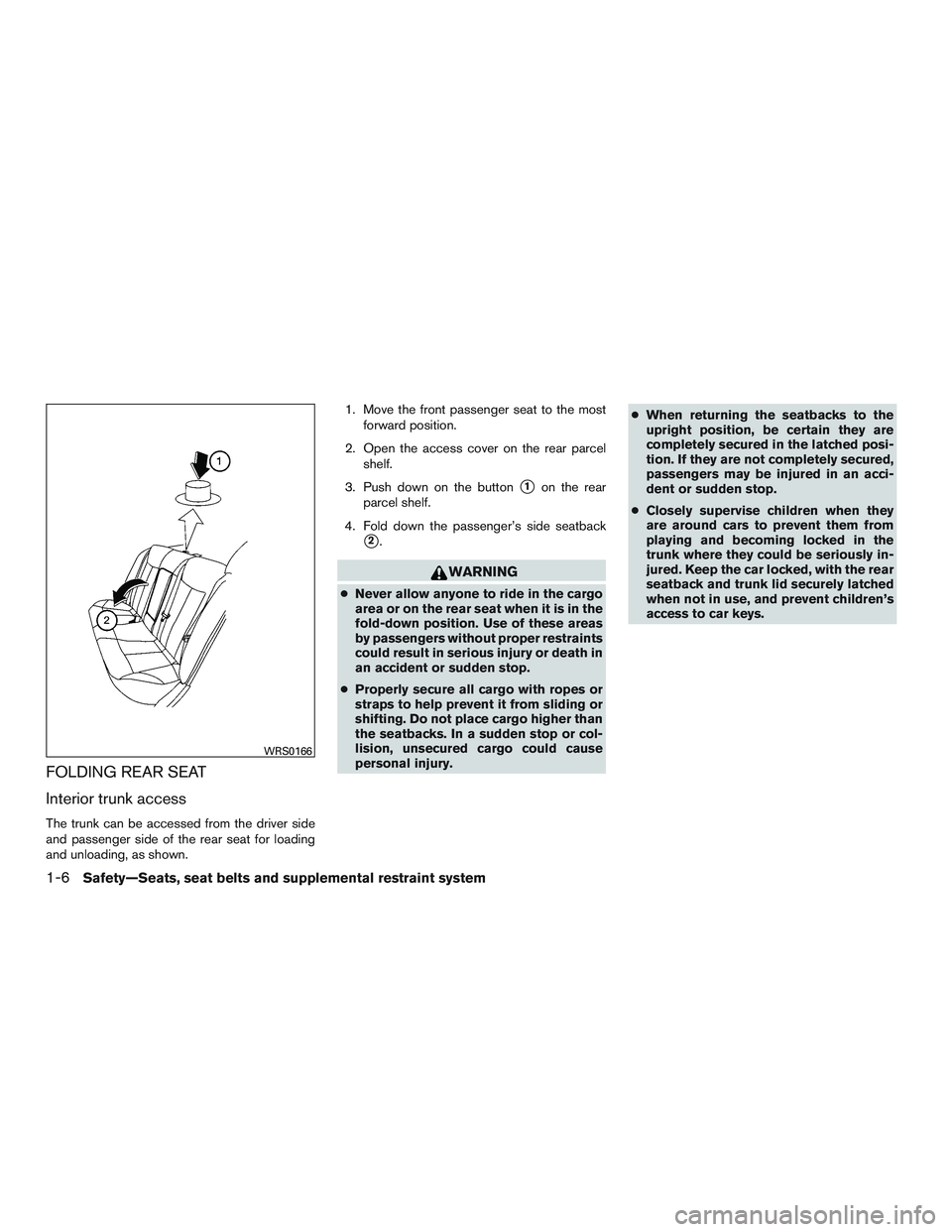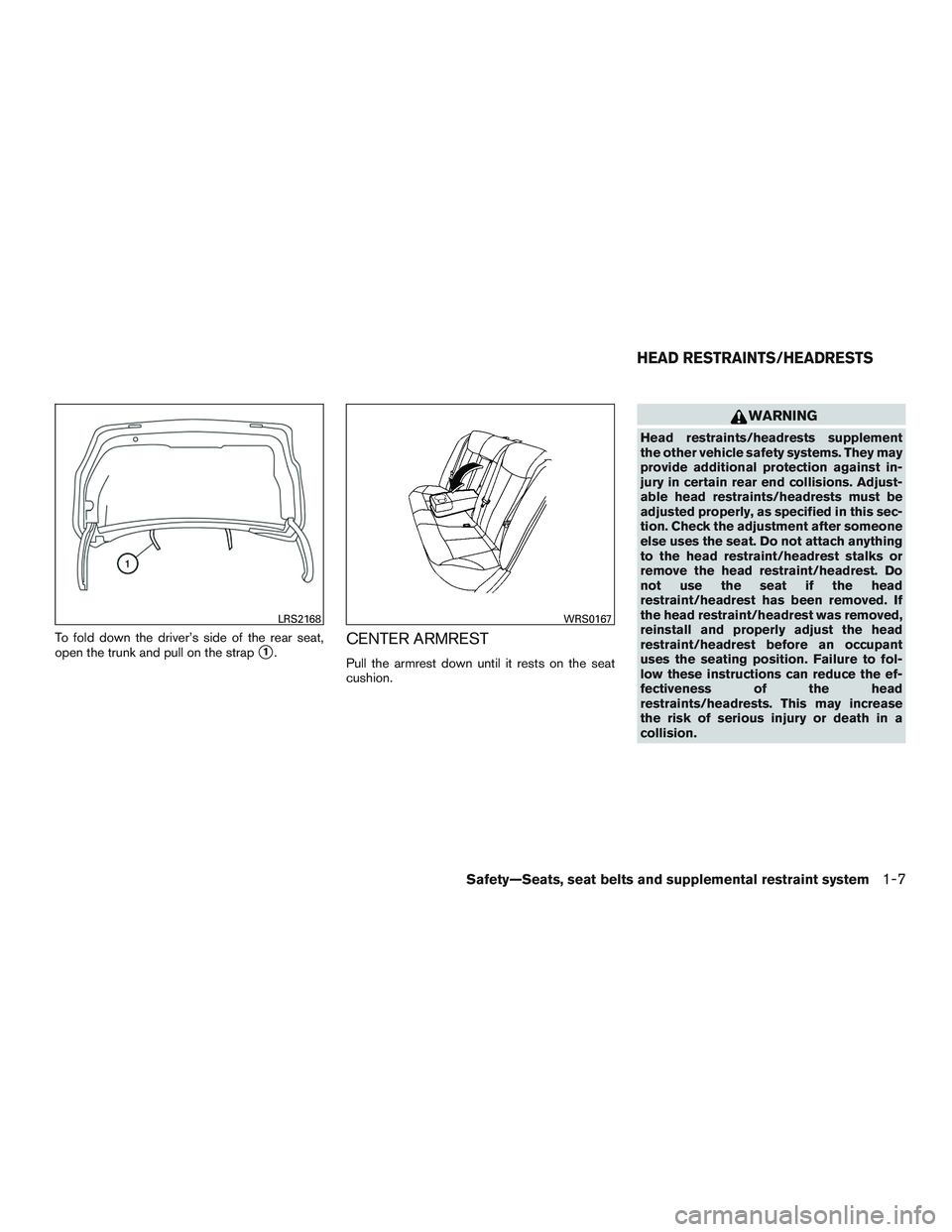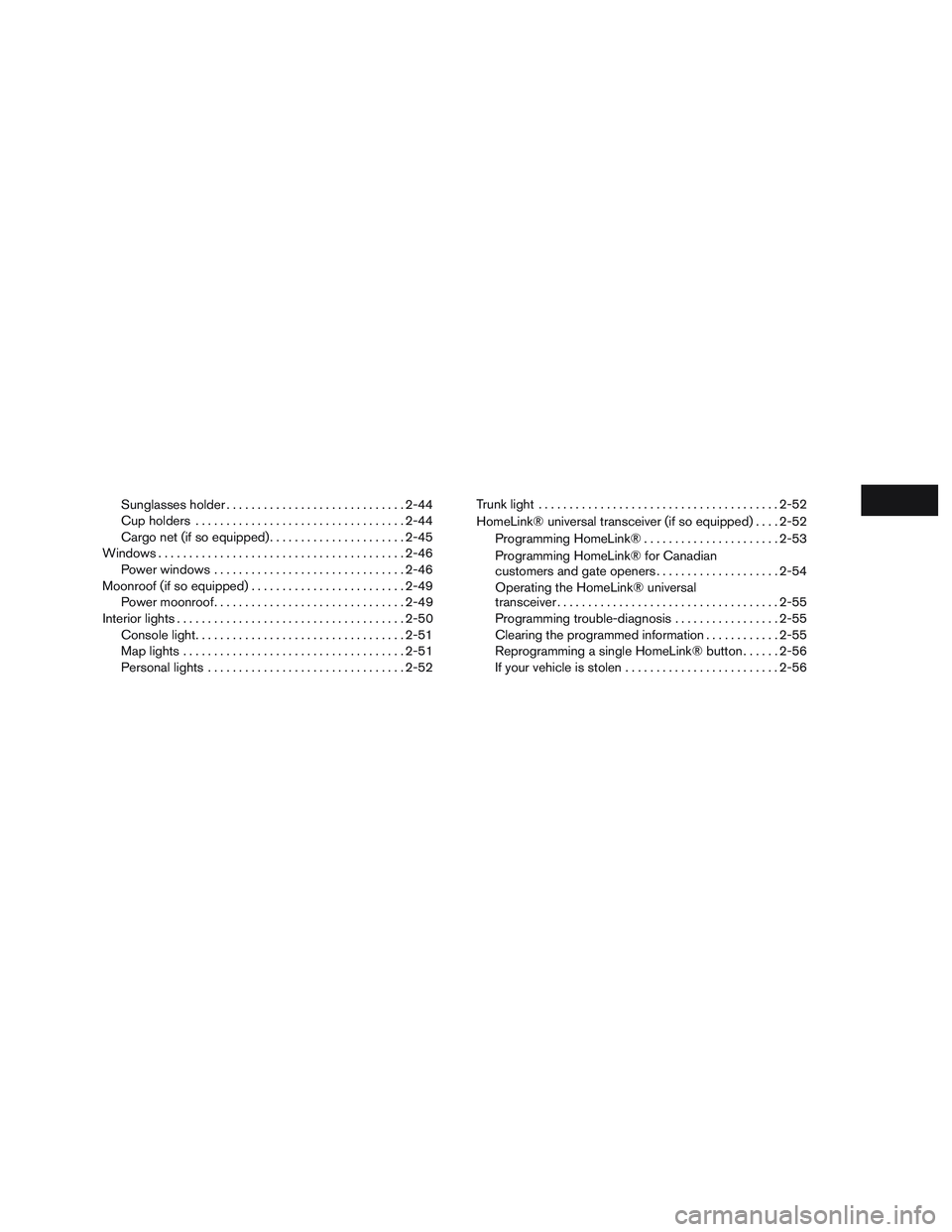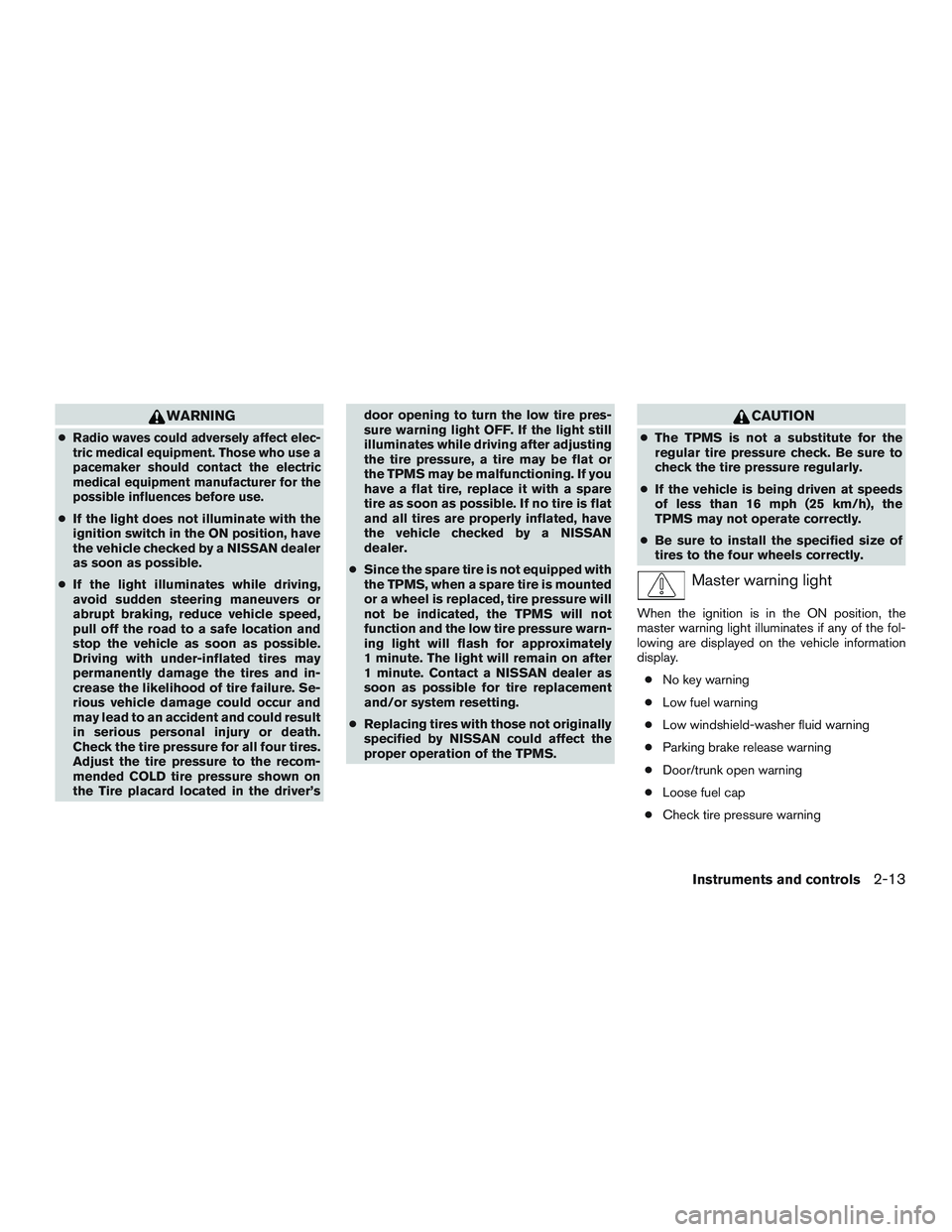Page 11 of 491
1. Rear window and outside mirror (if soequipped) defroster switch (P. 2-32)
2. Trunk lid (P. 3-30)
3. Rearview camera (if so equipped)
(P. 4-10)
4. Replacing bulbs (P. 8-29)
5. Fuel-filler cap (P. 3-32) Fuel recommendation (P. 9-2)
Fuel-filler door (P. 3-32)
6. Child safety rear door lock (P. 3-4)
Refer to the page number indicated in pa-
rentheses for operating details.
LII2379
EXTERIOR REAR
0-4Illustrated table of contents
Page 14 of 491
18. Audio system controls (P. 4-27)Cruise control main/set switch
(P. 5-39)
19. Tilt/telescopic steering wheel controls
(P. 3-35)
20. Vehicle information display controls
(P. 2-17)
Steering wheel switch for audio control
(if so equipped) (P. 4-27)
Bluetooth® Hands-free Phone System
(if so equipped) (P. 4-27)
21. Hood release (P. 3-29)
22. Trunk opener (P. 3-30) Vehicle Dynamic Control (VDC) OFF
switch (P. 2-39)
Heated steering wheel switch
(if so equipped) (P. 2-38)
*: Refer to the separate Navigation System Own-
er’s Manual (if so equipped) .
Refer to the page number indicated in pa-
rentheses for operating details.
Illustrated table of contents0-7
Page 23 of 491

FOLDING REAR SEAT
Interior trunk access
The trunk can be accessed from the driver side
and passenger side of the rear seat for loading
and unloading, as shown.1. Move the front passenger seat to the most
forward position.
2. Open the access cover on the rear parcel shelf.
3. Push down on the button
�1on the rear
parcel shelf.
4. Fold down the passenger’s side seatback
�2.
WARNING
● Never allow anyone to ride in the cargo
area or on the rear seat when it is in the
fold-down position. Use of these areas
by passengers without proper restraints
could result in serious injury or death in
an accident or sudden stop.
● Properly secure all cargo with ropes or
straps to help prevent it from sliding or
shifting. Do not place cargo higher than
the seatbacks. In a sudden stop or col-
lision, unsecured cargo could cause
personal injury. ●
When returning the seatbacks to the
upright position, be certain they are
completely secured in the latched posi-
tion. If they are not completely secured,
passengers may be injured in an acci-
dent or sudden stop.
● Closely supervise children when they
are around cars to prevent them from
playing and becoming locked in the
trunk where they could be seriously in-
jured. Keep the car locked, with the rear
seatback and trunk lid securely latched
when not in use, and prevent children’s
access to car keys.
WRS0166
1-6Safety—Seats, seat belts and supplemental restraint system
Page 24 of 491

To fold down the driver’s side of the rear seat,
open the trunk and pull on the strap
�1.CENTER ARMREST
Pull the armrest down until it rests on the seat
cushion.
WARNING
Head restraints/headrests supplement
the other vehicle safety systems. They may
provide additional protection against in-
jury in certain rear end collisions. Adjust-
able head restraints/headrests must be
adjusted properly, as specified in this sec-
tion. Check the adjustment after someone
else uses the seat. Do not attach anything
to the head restraint/headrest stalks or
remove the head restraint/headrest. Do
not use the seat if the head
restraint/headrest has been removed. If
the head restraint/headrest was removed,
reinstall and properly adjust the head
restraint/headrest before an occupant
uses the seating position. Failure to fol-
low these instructions can reduce the ef-
fectiveness of the head
restraints/headrests. This may increase
the risk of serious injury or death in a
collision.
LRS2168WRS0167
HEAD RESTRAINTS/HEADRESTS
Safety—Seats, seat belts and supplemental restraint system1-7
Page 80 of 491

Sunglasses holder............................. 2-44
Cup holders .................................. 2-44
Cargo net (if so equipped) ......................2-45
Windows ........................................ 2-46
Power windows ............................... 2-46
Moonroof (if so equipped) ......................... 2-49
Power moonroof ............................... 2-49
Interior lights ..................................... 2-50
Console light .................................. 2-51
Map lights .................................... 2-51
Personal lights ................................ 2-52Trunk light
....................................... 2-52
HomeLink® universal transceiver (if so equipped) ....2-52
Programming HomeLink® ......................2-53
Programming HomeLink® for Canadian
customers and gate openers ....................2-54
Operating the HomeLink® universal
transceiver .................................... 2-55
Programming trouble-diagnosis .................2-55
Clearing the programmed information ............2-55
Reprogramming a single HomeLink® button ......2-56
If your vehicle is stolen ......................... 2-56
Page 82 of 491
18. Audio system controls (P. 4-27)Cruise control main/set switch
(P. 5-39)
19. Tilt/telescopic steering wheel controls
(P. 3-35)
20. Vehicle information display controls
(P. 2-17)
Steering wheel switch for audio control
(if so equipped) (P. 4-27)
Bluetooth® Hands-free Phone System
(if so equipped) (P. 4-27)
21. Hood release (P. 3-29)
22. Trunk opener (P. 3-30) Vehicle Dynamic Control (VDC) OFF
switch (P. 2-39)
Heated steering wheel switch
(if so equipped) (P. 2-38)
*: Refer to the separate Navigation System Own-
er’s Manual (if so equipped) .
Refer to the page number indicated in pa-
rentheses for operating details.
1. Tachometer
2. Warning and indicator lights
3. Vehicle information display
4. Speedometer
5. Fuel gauge 6. Odometer
Twin trip odometer
7. Engine coolant temperature gauge
LIC2254
METERS AND GAUGES
Instruments and controls2-3
Page 92 of 491

WARNING
●Radio waves could adversely affect elec-
tric medical equipment. Those who use a
pacemaker should contact the electric
medical equipment manufacturer for the
possible influences before use.
● If the light does not illuminate with the
ignition switch in the ON position, have
the vehicle checked by a NISSAN dealer
as soon as possible.
● If the light illuminates while driving,
avoid sudden steering maneuvers or
abrupt braking, reduce vehicle speed,
pull off the road to a safe location and
stop the vehicle as soon as possible.
Driving with under-inflated tires may
permanently damage the tires and in-
crease the likelihood of tire failure. Se-
rious vehicle damage could occur and
may lead to an accident and could result
in serious personal injury or death.
Check the tire pressure for all four tires.
Adjust the tire pressure to the recom-
mended COLD tire pressure shown on
the Tire placard located in the driver’s door opening to turn the low tire pres-
sure warning light OFF. If the light still
illuminates while driving after adjusting
the tire pressure, a tire may be flat or
the TPMS may be malfunctioning. If you
have a flat tire, replace it with a spare
tire as soon as possible. If no tire is flat
and all tires are properly inflated, have
the vehicle checked by a NISSAN
dealer.
● Since the spare tire is not equipped with
the TPMS, when a spare tire is mounted
or a wheel is replaced, tire pressure will
not be indicated, the TPMS will not
function and the low tire pressure warn-
ing light will flash for approximately
1 minute. The light will remain on after
1 minute. Contact a NISSAN dealer as
soon as possible for tire replacement
and/or system resetting.
● Replacing tires with those not originally
specified by NISSAN could affect the
proper operation of the TPMS.
CAUTION
● The TPMS is not a substitute for the
regular tire pressure check. Be sure to
check the tire pressure regularly.
● If the vehicle is being driven at speeds
of less than 16 mph (25 km/h), the
TPMS may not operate correctly.
● Be sure to install the specified size of
tires to the four wheels correctly.
Master warning light
When the ignition is in the ON position, the
master warning light illuminates if any of the fol-
lowing are displayed on the vehicle information
display.
● No key warning
● Low fuel warning
● Low windshield-washer fluid warning
● Parking brake release warning
● Door/trunk open warning
● Loose fuel cap
● Check tire pressure warning
Instruments and controls2-13
Page 104 of 491
VEHICLE INFORMATION DISPLAY
WARNINGS AND INDICATORS
1. No Key Detected
2. Key ID Incorrect
3. Shift to Park4. Push ignition to OFF
5. Key Battery Low
6. Engine start operation for Intelligent Key®
system
7. Release Parking brake 8. Low Fuel
9. Low Washer Fluid (if so equipped)
10. Door Open
11. Trunk Open
LIC3438
Instruments and controls2-25